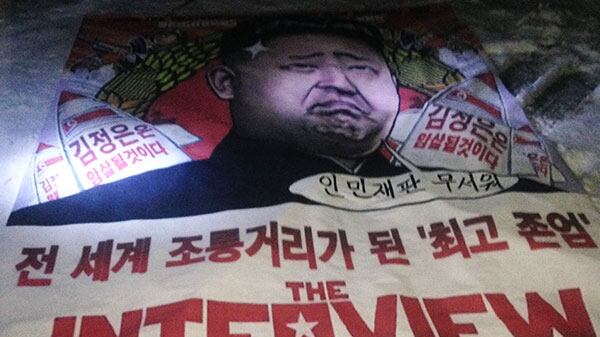PAJU, SOUTH KOREA — They may not look dangerous, but to North Korean supreme leader Kim Jong Un the 100,000 pro-democracy leaflets and a giant advertisement for The Interview secretly launched into the air on hydrogen balloons Monday night are very threatening indeed.
In the past, Pyongyang has called the North Korean defectors who organize such covert launches—undertaken in the dead of night to avoid the attention of the South Korean government, which considers them unnecessarily provocative—“human scum.” For good measure, the North Korean military has promised to “physically eliminate” anyone who dares to send any material into the hands of its citizens, thereby breaking its information monopoly.
The threats did not dissuade a hearty band of North Korean defectors, their South Korean allies, Silicon Valley technologists, and a global team of pro-democracy activists, who braved sub-zero temperatures late Monday night to send word about Sony’s controversial movie The Interview into one of the world’s darkest corners.
The instigator for this adventure was Park Sang Hak, a man targeted as “Enemy Zero” by the North for his anti-regime activities. The son of a former high-ranking official who himself defected in 1999, Park followed his father into exile, crossing the Yalu River into China with his mother, brother, and sister. It is hard to fathom how this fiery man, whose hatred for the North Korean slave state cannot be contained, lived a quiet life for the next four years, but he did not choose a path of activism until 2003. For that was when he learned that his uncle, still living in the North, had been tortured to death on account of his escape.
Over the past decade, Park and his Fighters for a Free North Korea have sent dozens of balloons to the North, releasing 60-80 million leaflets into the sky, with varying rates of success (it is hard to tell how many of the balloons actually reach their intended targets because so few people escape North Korea into the South—only around 25,000 in the past 20 years). Yet Park’s activism has earned the ire of Pyongyang, which in 2011 dispatched a double agent to the South to kill him with a poison-tipped pen.
This week’s launch was especially prominent, however, in light of the recent computer hack of Sony Pictures, widely suspected to have been perpetrated by North Korea in reaction to Sony’s production of The Interview, a ribald comedy mocking the Hermit Kingdom and its erratic leader. (After canceling a wide theatrical release, Sony made the film available online.) Park enlisted the help of the New York-based Human Rights Foundation, which launched a “Hack Them Back” campaign aimed at raising funds to send 100,000 copies of The Interview on DVD and USB into the North. Though the group did not send copies of the film on this launch, it plans to do so “on a rolling basis” over the next few months.
Contrary to popular conception, North Koreans are not as isolated from the outside world as we may think, despite the best efforts of their captors. A 2010 survey of North Korean refugees found that 48 percent had viewed DVDs, a 28 percent increase from just two years prior. “The idea that there’s anybody in North Korea with a DVD player was alien to me,” Alex Lloyd, a co-founder of HRF’s North Korea initiative, told me. It was data like this that inspired him and HRF President Thor Halvorssen to team up with Park and other defectors to find ways to improve the balloon technology in order to get vital information into the hands of North Koreans.
And so that was how I found myself in the freezing cold, just a few miles from the Demilitarized Zone (which is, oxymoronically, one of the most heavily militarized places on earth), waiting in the snow with a group of Koreans busily shouting commands at one another. Halvorssen had only given the group an hour’s warning. Though we knew the balloon launch would be occurring sometime this week, he had kept the specifics a secret so as not to let details leak to the South Korean media; both the government and left-wing groups have repeatedly tried to interfere with previous balloon launches. Yet wind conditions were most favorable on Monday night. Another consideration: “We’re doing it now because the longer we’re in country, the more suspicious it becomes.”
By the time we made it out to a small field off the highway near the North Korean border, everything was set for a perfect launch except… the balloons. It appeared Park forgot to bring the balloons from the facility outside Seoul where the rest of the supplies were stored. “I am sorry,” a dejected Park said to the huddled crowd. “They brought the materials. They just forgot the balloons. Even monkeys fall out of trees and I forgot the balloons.”
We piled back into the mini-bus while the North Koreans drove back to fetch the balloons. Whiling away the time drinking Soju, a cheap Korean whiskey, Park regaled us with stories about the countless times South Korean police have arrested him for previous balloon launches. Park grates on the South Korean conscience, constantly reminding them of the moral debt they owe to their brothers in the North. There is a pervasive reticence here about discussing the North’s abysmal human-rights situation, a concern Park raises the next day, when, at his press conference discussing the launch, I ask him about The Interview. It’s telling, he says, that the movie was made in America, not South Korea. “I felt guilty we couldn’t make this movie and we are silent about the human-rights violations in North Korea.” The scene that most resonates with him is one in which Kim Jong Un and James Franco douse a bevy of topless sex slaves with Champagne. To the film’s frat-boy fan base, it’s a laugh riot. For Park, it was a frank commentary on the regime’s utter depravity.

Once the Koreans returned with the balloons, sometime around 11:30 p.m., the launch was a smoothly run operation. The leaflets—contrasting the last, three democratically elected leaders of South Korea with the dynastic trio that has ruled the North for nearly seven decades—were mixed with U.S. dollar bills (to assist North Koreans to bribe their way out of the country)—and placed in bags. The activists also sent up a giant poster emblazoned with a caricature of the Dear Leader and the typeface of The Interview. Across it read, “Kim Jong Un will be assassinated,” and a text box: “I’m afraid of the judgment of the people.” Once inflated with hydrogen, the balloons looked like giant condoms. With the soundtrack of The Interview playing in the background, and to chants of “Death to Kim Jong Un!” and “Free the North Korean People!” we lifted the balloons—all five of them—into the sky.
Todd Huffman, a technologist from San Francisco recruited to help assist the team with geolocation dynamics, had placed a $150 GPS tracker on one of the balloons, whose path he charts on his smartphone. Every two minutes, he refreshed his screen to track the balloon’s journey. As we drove back to Seoul, it appeared that the balloon is beating us—that is, it’s headed in the wrong direction, south, away from where we wanted it to go. Yet there are still four other balloons, with some 80,000 leaflets. If just one of those leaflets finds its way before the eyes of a North Korean citizen, then the effort will have been worth it. While there’s no aspect of its subjects’ lives that the North Korean regime doesn’t command, the Dear Leader cannot alter nature, despite the myths propagated in his name. As Halvorssen says, “The dictatorship does not control the wind.”





